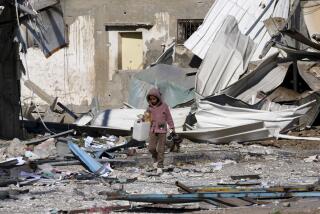Funds Reportedly Aided Afghan Rebels : CIA Arms Account Was Also Used by Saudi Arabia
- Share via
WASHINGTON — Part of the millions paid by Iran for U.S.-made weapons was deposited in a $500-million CIA-managed bank account secretly used by the United States and Saudi Arabia to buy arms for the anti-Soviet Afghan resistance, government sources said Wednesday.
The accounting arrangement, which mixed the finances of the congressionally approved Afghan program with an Iranian operation hidden from Congress, was called by one official an “unforgivable blunder” that was committed in haste and never corrected.
However, the CIA and other officials flatly denied a news report stating that the CIA-managed account included $10 million to $30 million in cash skimmed from the Iran arms sales and later diverted to support the contra rebels in Nicaragua .
Report Cites Violation
That report, in the Washington Post, quoted congressional investigators as saying that the CIA allotted money from the account to fund the contras in violation of a congressional ban on U.S. military aid to the rebel army.
“We didn’t have anything to do with it (the diversion) directly or indirectly,” CIA spokesman George Lauder said Wednesday. “I just talked with our controller. He’s got every nickel” accounted for.
A congressional source, speaking on a pledge of anonymity, said that CIA officials had been subjected only to “incomplete interrogation” on the matter by congressional investigators and that allegations of impropriety were “premature.”
Proof that the CIA diverted any of the Iranian arms money to the contras would dramatically widen the Iran scandal, which so far is confined to allegations that a handful of White House National Security Council officials, led by Marine Lt. Col. Oliver L. North, knew of and approved the cash-skimming plans.
The Post article quoted a Reagan Administration source as saying that all receipts from Iranian purchases of U.S.-made weapons were placed in a CIA account in Switzerland from which “the various accounts involving the Reagan doctrine are administered.”
The account in question, government sources said Wednesday, includes $250 million in deposits from both the United States and Saudi Arabia that are used to buy Soviet Bloc weapons for distribution to resistance forces battling the Soviet occupation of Afghanistan.
The Post report, quoting congressional sources, said the account also financed secret purchases of weapons that were then sent to the contras and “freedom fighters” in pro-Soviet Angola.
CIA Explains Deposits
CIA spokesman Lauder said Wednesday that some receipts from Iranian arms purchases were placed in the numbered Swiss account. But the total deposits, he said, covered only the cost to the Defense Department of the weapons themselves and their transportation to Iran, a figure publicly estimated at about $12 million.
“We in effect got billed” by the Defense Department for the cost of U.S. weapons sent to Iran, Lauder said. “When the money was paid to us, it moved in in chunks and we passed it right on to the Pentagon.”
He did not say where the estimated $10 million to $30 million in profits generated by the arms sales was deposited, but Atty. Gen. Edwin Meese III said last week that those funds were placed in bank accounts under control of the contras.
One informed source, speaking on a promise of anonymity, said Wednesday that CIA finance officials apparently allowed the Iranian monies to be placed in the Afghan account in haste after being approached on an “emergency” basis by the NSC’s North.
In related matters, the CIA was reported Wednesday to have given congressional intelligence committees a new version of its role in a secret arms shipment to Iran in November, 1985, two months before President Reagan signed an order approving such shipments.
Members of Congress have asked questions about the 1985 shipment because it marked the CIA’s first involvement in the Iranian arms deal and because the agency acted without formal authorization from the White House.
According to a congressional source, the CIA now says that neither CIA Director William J. Casey nor his deputy in November, 1985, John N. McMahon, approved the agency’s decision to grant “logistical help” to that shipment.
The agency also said it helped move the shipment from Lisbon to Iran under the mistaken belief that it included oil drilling parts, not weapons, the source said.
Casey Clarifies Role
Casey had told the House and Senate intelligence panels on Nov. 21 that McMahon approved the shipment while Casey was in China. After McMahon objected vigorously to that version, Casey told the committees that he had “misspoken,” and several congressional sources said he had personally approved CIA aid for the shipment.
In the latest explanation, the CIA told congressional officials that the authorization for logistical aid for the arms came from a third, lower-ranking CIA officer.
“We still don’t know what really happened,” a congressional official said. “Casey has not made anything clear.”
The White House has said that President Reagan did not know of the November shipment until three months after it occurred. The source of U.S. approval for the arms--the first shipment directly aided by the United States--has not been established, at least publicly.
Staff writer Karen Tumulty contributed to this story.
More to Read
Sign up for Essential California
The most important California stories and recommendations in your inbox every morning.
You may occasionally receive promotional content from the Los Angeles Times.











